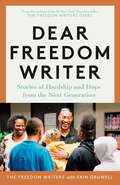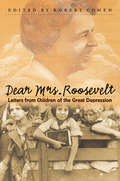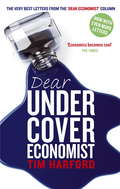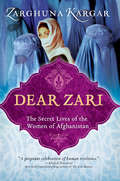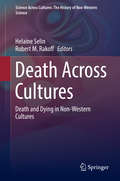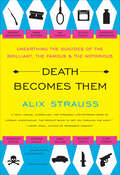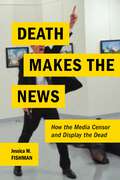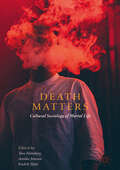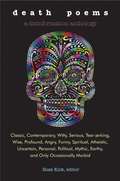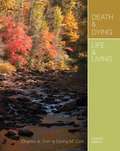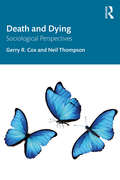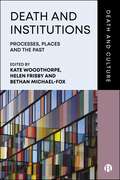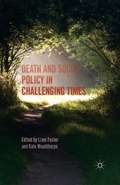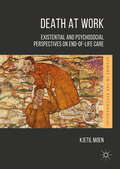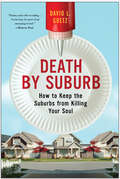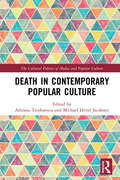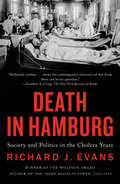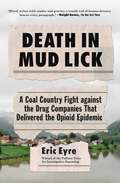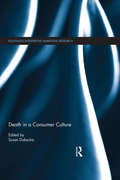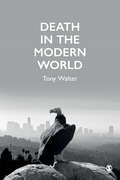- Table View
- List View
Dear Freedom Writer: Stories of Hardship and Hope from the Next Generation
by Erin Gruwell The Freedom WritersThe students of today tell their stories of adversity and growth in letters to the original Freedom Writers—authors of the #1 New York Times bestseller The Freedom Writers Diary—who write supportive and powerful letters in response.Over twenty years ago, the students in first-year teacher Erin Gruwell&’s high school class in Long Beach, California, were labeled &“unteachable&”—but she saw past that. Instead of treating them as scores on a test, she understood that each of them had a unique story to tell. Inspired by books like Anne Frank&’s diary, her students began writing their own diaries, eventually dubbing themselves the Freedom Writers. Together, they co-authored The Freedom Writers Diary, which launched a movement that remains incredibly relevant and impactful today. Their stories speak to young people who feel as if those around them do not care about their lives, their feelings, and their struggles. They want to be heard; they want to be seen.In Dear Freedom Writer, the next generation of Freedom Writers shares its struggles with abuse, racism, discrimination, poverty, mental health, imposed borders, LGBTQIA+ identity, and police violence. Each story is answered with a letter of advice from an original Freedom Writer. With empathy and honesty, they address these young people not with the platitudes of a politician or a celebrity, but with the pragmatic advice of people who have dealt with these same issues and come out on the other side.Through its eye-opening and inspiring stories, Dear Freedom Writer paints an unflinchingly honest portrait of today&’s youth and offers a powerful message of perseverance, understanding, and hope.
Dear Mrs. Roosevelt
by Robert CohenImpoverished young Americans had no greater champion during the Depression than Eleanor Roosevelt. As First Lady, Mrs. Roosevelt used her newspaper columns and radio broadcasts to crusade for expanded federal aid to poor children and teens. She was the most visible spokesperson for the National Youth Administration, the New Deal's central agency for aiding needy youths, and she was adamant in insisting that federal aid to young people be administered without discrimination so that it reached blacks as well as whites, girls as well as boys.<P><P> This activism made Mrs. Roosevelt a beloved figure among poor teens and children, who between 1933 and 1941 wrote her thousands of letters describing their problems and requesting her help. Dear Mrs. Roosevelt presents nearly 200 of these extraordinary documents to open a window into the lives of the Depression's youngest victims. In their own words, the letter writers confide what it was like to be needy and young during the worst economic crisis in American history.<P> Revealing both the strengths and the limitations of New Deal liberalism, this book depicts an administration concerned and caring enough to elicit such moving appeals for help yet unable to respond in the very personal ways the letter writers hoped.
Dear Teacher: 100 Days of Inspirational Quotes and Anecdotes
by Brad Johnson Hal BowmanDear teacher, you are appreciated! This inspirational book, written by motivational speakers Brad Johnson and Hal Bowman, provides daily encouragement to thank you for all that you do in the classroom and beyond. Johnson and Bowman offer quotes and powerful stories for 100 days of the school year, highlighting topics such as celebrating small successes, bringing out the best in your students, knowing your worth, and being all in. The book is perfect for teachers of all grade levels, and for principals to buy their teachers for schoolwide morale, to keep teachers feeling their best. The uplifting advice will remind you why you’ve chosen this profession and the impact you have on others!
Dear Undercover Economist: The very best letters from the Dear Economist column
by Tim HarfordAre there tangible benefits in flossing? Is it wrong to fake orgasms? What does the perfect online dating ad look like? Should we bother doing the ironing? Is it really impossible to buy the perfect Christmas gift? (Other than this book, of course.)Economists might not be the first people you would think of to give you advice on such diverse areas as parenting, the intricacies of etiquette or the dark arts of seduction. But for years bestselling author Tim Harford has been doing just that: answering the most challenging questions in his brilliant column, where he uses the tools of economics to give practical advice about everyday dilemmas, conundrums and concerns. From family rows and the stock market to buying socks or speed dating, you'll find within these pages a witty - and of course rational - explanation for almost everything you ever wanted to know about life.
Dear Zari
by Zarghuna KargarZARGHUNA KARGAR was born in Kabul in 1982. After Soviet troops forced out the government -- in which her father was minister for information -- and civil war erupted across Afghanistan, she and her family sought refuge in Pakistan. Zarghuna completed her education in Peshawar in Pakistan: she studied at a refugee university and attended a journalism course organised by the BBC. Then in 2001 her family sought asylum in the UK, and she started working for the BBC World Service Pashto Section. She joined the team on the ground-breaking programme Afghan Woman's Hour, as producer and presenter in 2004, until it was discontinued in 2010. Zarghuna now works on current affairs programmes for the BBC Afghan Service, frequently covering topics relating to women's issues. She lives in London.
Death Across Cultures: Death and Dying in Non-Western Cultures (Science Across Cultures: The History of Non-Western Science #9)
by Helaine Selin Robert M. RakoffDeath Across Cultures: Death and Dying in Non-Western Cultures, explores death practices and beliefs, before and after death, around the non-Western world. It includes chapters on countries in Africa, Asia, South America, as well as indigenous people in Australia and North America. These chapters address changes in death rituals and beliefs, medicalization and the industry of death, and the different ways cultures mediate the impacts of modernity. Comparative studies with the west and among countries are included. This book brings together global research conducted by anthropologists, social scientists and scholars who work closely with individuals from the cultures they are writing about.
Death And Decision
by Ernan Mc MullinThis book discusses the moral, medical, legal, and economic issues that demand the sensitive attention of doctors, theologians, philosophers, social workers and lawyers, whose work brings them in contact with the kind of decision the voluntary termination of life represents. .
Death Becomes Them: Unearthing the Suicides of the Brilliant, the Famous & the Notorious
by Alix StraussKurt Cobain, Anne Sexton, Mark Rothko, Ernest Hemingway, Adolf Hitler . . . all famous, some rich and powerful, some beloved, some abhorred. But when life and circumstance got to be too much, each headed for the exit door. Sigmund Freud overdosed on morphine. Dorothy Dandridge stripped naked and swallowed a handful of antidepressants. Hunter S. Thompson shot himself while talking to his wife on the phone.These are the lonely personal nightmares behind celebrity suicides—the deaths and their causes are as diverse as the victims themselves. In Death Becomes Them, Alix Strauss bids each one a final good-bye while examining the last days and the unbearable incidents that drove these notables to end their lives. She decodes their notes, touches on their accomplishments, and delves into the methodologies of their deaths using autopsy and police reports and personal photos. Strauss also explores the morbid curiosity that feeds our fixation with famously tortured souls and provides lists of other controversial, bizarre, and poorly executed suicides in this mammoth tome.
Death Makes the News: How the Media Censor and Display the Dead
by Jessica M. FishmanWinner of the 2018 Media Ecology Association's Erving Goffman Award for Outstanding Scholarship in the Ecology of Social InteractionWinner of the Eastern Communication Association's Everett Lee Hunt AwardA behind-the-scenes account of how death is presented in the mediaDeath is considered one of the most newsworthy events, but words do not tell the whole story. Pictures are also at the epicenter of journalism, and when photographers and editors illustrate fatalities, it often raises questions about how they distinguish between a “fit” and “unfit” image of death.Death Makes the News is the story of this controversial news practice: picturing the dead. Jessica Fishman uncovers the surprising editorial and political forces that structure how the news and media cover death. The patterns are striking, overturning long-held assumptions about which deaths are newsworthy and raising fundamental questions about the role that news images play in our society.In a look behind the curtain of newsrooms, Fishman observes editors and photojournalists from different types of organizations as they deliberate over which images of death make the cut, and why. She also investigates over 30 years of photojournalism in the tabloid and patrician press to establish when the dead are shown and whose dead body is most newsworthy, illustrating her findings with high-profile news events, including recent plane crashes, earthquakes, hurricanes, homicides, political unrest, and war-time attacks. Death Makes the News reveals that much of what we think we know about the news is wrong: while the patrician press claims that they do not show dead bodies, they are actually more likely than the tabloid press to show them—even though the tabloids actually claim to have no qualms showing these bodies. Dead foreigners are more likely to be shown than American bodies. At the same time, there are other unexpected but vivid patterns that offer insight into persistent editorial forces that routinely structure news coverage of death. An original view on the depiction of dead bodies in the media, Death Makes the News opens up new ways of thinking about how death is portrayed.
Death Matters: Cultural Sociology of Mortal Life
by Fredrik Palm Tora Holmberg Annika JonssonThis book investigates death as part of contemporary everyday experience and practices. Through a cultural sociological lens, it studies death as it remains constantly at the edge of our consciousness, shaping the ways in which we move through social reality. As such, Death Matters is a significant contribution to death studies, going beyond traditional parameters of the field by addressing the cultural omnipresence of death.The contributions analyse several death-related meaning-making processes, arguing that meanings emerging from culturally shared narratives, social institutions, and material conditions, are just as important as ’death practices’ in understanding the role of death in society. Drawing on the related themes of places of absence and presence, disease and bodies, and persons and non-persons, the authors explore a variety of areas of social life, from haunting to celebrity deaths, to move the notion of death from the margins of social reality to ongoing everyday life.This far-reaching collection will be of use to scholars and students across death studies, sociology, anthropology, philosophy, culture, media and communication studies.
Death Poems: Classic, Contemporary, Witty, Serious, Tear-Jerking, Wise, Profound, Angry, Funny, Spiritual, Atheistic, Uncertain, Personal, Political, Mythic, Earthy, and Only Occasionally Morbid
by Russ Kick<p>Pretty much every poet in every age has written about death and dying. Along with love, it might be the most popular subject in poetry. Yet, until now, no anthology has gathered the best and most famous of these verses in one place. <p>This collection ranges dramatically. With more than 320 poems, it goes across all of history, from the ancients straight through to today. Across countries and languages, across schools of poetry. You’ll find a plethora of approaches—witty, humorous, deadly serious, tear-jerking, wise, profound, angry, spiritual, atheistic, uncertain, highly personal, political, mythic, earthy, and only occasionally morbid. <p>Every angle you can think of is covered—the deaths of children, lost loves, funeral rites, close calls, eating meat, serial killers, the death penalty, roadkill, the Underworld, reincarnation, elegies for famous people, death as an equalizer, death as a junk man, death as a child, the death of God, the death of death . . . .</p>
Death Without Weeping: The Violence Of Everyday Life In Brazil
by Nancy Scheper-HughesDeath Without Weeping is a work of passion, a nontraditional ethnography charged with political commitment and moral vigor. It is a tour de force that will be discussed and debated for many years to come.
Death and Dying, Life and Living
by Charles A. Corr Clyde M. Nabe Donna M. CorrPractical and inspiring, this field-leading book helps students learn how to navigate encounters with death, dying, and bereavement. The authors integrate classical and contemporary material, present task-based approaches for individual and family coping, and include four substantial chapters devoted to death-related issues faced by children, adolescents, young and middle-aged adults, and older adults. The book discusses a variety of cultural and religious perspectives that affect people's understanding and practices associated with such encounters. Practical guidelines for constructive communication are designed to encourage productive living in the face of death.
Death and Dying: Sociological Perspectives
by Neil Thompson Gerry R. CoxDeath and Dying is an important core text for students and professionals interested in developing a holistic understanding of death and dying. Chapters are replete with case studies, activities, key point boxes, and other features that enable readers to develop a sociologically informed understanding of the broad range of complex issues that underpin death and dying. Written by two established and highly respected experts in the field, it offers a thoroughgoing account of a wide range of social aspects of death and dying, filling gaps left by the traditionally narrow focus of the existing literature. By drawing the suggested sociological perspectives and highlighting the role of social policy, the authors put forward a fresh perspective of the field of thanatology. This book is a major contribution in progressing knowledge and understanding of dying and death for students and professionals in counseling, health and human services.
Death and Institutions: Processes, Places and the Past (Death and Culture)
by Kate Woodthorpe, Helen Frisby and Bethan Michael-FoxInstitutions play a crucial role in shaping experiences of end-of-life care, dying, death, body disposal and bereavement. However, there has been little holistic or multidisciplinary research in this area, with studies typically focusing on individual settings such as hospitals and cemeteries, or being confined to specific disciplines. This interdisciplinary collection combines chapters on process, place and the past to examine the relationships both within and between institutions, institutionalization and death in international contexts. Of broad appeal to students and academics in areas including social policy, health sciences, sociology, psychology, anthropology, cultural studies, history and the wider humanities, this collection spans multiple disciplines to offer crucial insights into the end of life, body disposal, bereavement and mourning.
Death and Social Policy in Challenging Times
by Liam Foster Kate WoodthorpeThe study of death has the capacity to bring together a range of policy areas. Yet death is often overlooked within policy debates in the UK and beyond, and within gerontology. Bringing together a range of scholars engaged in policy associated with death, this collection provides a holistic account of how death factors in social policy. Within this, issues covered include inheritance, palliative care, euthanasia, funeral costs, bereavement support, marginalised deaths and disposal practices. At the heart of the book, the volume recognises that the issues identified are likely to intensify and expand over the next twenty years, as death rates continue to rise.
Death and the Afterlife: Multidisciplinary Perspectives from a Global City (Routledge Advances in Sociology)
by Terence Heng Kit Ying LyeWhat insights can we gain from the rituals, actions, and interactions around death and the afterlife? This edited collection offers a multidisciplinary perspective on how individuals and collectives “do” death and interact with the dead.Through case studies of Singaporean Chinese religion communities, the authors bring a myriad of knowledge and experience from eight different but interconnected disciplines to examine, map, document, and theorise the practices of death and the afterlife. Heritage here is not just a point of nostalgia or historical snapshot, but becomes a significant resource for the shaping of and grappling with diasporic and contemporary Singaporean Chinese identities. This edited collection moves beyond “western” sites of knowledge by offering a series of multidisciplinary perspectives on death practices, drawn from research with individuals, groups, and organisations that identify themselves as Singaporean Chinese, and the spaces and places often referred to as "Chinese Singapore".This collection will appeal to a wide and diverse audience of scholars, students, and practitioners. In particular, key target audiences would include, but are not limited to those interested in Asia, particularly Chinese studies and Chinese migrant/diasporic communities, and scholars in sociology, history, anthropology, and social/cultural geography.
Death at Work: Existential and Psychosocial Perspectives on End-of-Life Care (Studies in the Psychosocial)
by Kjetil MoenThis book explores how, in encounters with the terminally ill and dying, there is something existentially at stake for the professional, not only the patient. It connects the professional and personal lives of the interviewees, a range of professionals working in palliative and intensive care. Kjetil Moen discusses how the inner and outer worlds, the psychic and the social, and the existential and the cultural, all inform professionals’ experience of work at the boundary between life and death. Death at Work is written for an academic audience, but is accessible to and offers insights for practitioners in a variety of fields.
Death by Suburb: How to Keep the Suburbs from Killing Your Soul
by Dave L. GoetzA “funny and self-revealing” meditation on keeping your faith alive and vibrant in a world of strip malls, SUVs, and soccer games (Denver Post).Many seekers find themselves adrift in the seemingly unreal world of the suburbs. They read spirituality books, but struggle to stay connected to God while doing carpool duty or coaching soccer. In this book, Dave Goetz, a former pastor, shows that the suburbs are indeed a real world—but a spiritually corrosive one that can truly be toxic to the soul. Suburbanites need to understand how this comfortable, predictable environment affects them and what spiritual disciplines are needed for their faith to survive and thrive. Goetz identifies eight toxins in the suburban life, such as hyper-competition and the “transactional” friendship, and suggests eight corresponding disciplines to keep the spiritual life authentic. Goetz weaves sociology studies, his own experiences, current events, wisdom of the spiritual masters, and a little humor to equip spiritual suburbanites for relating to God amid Starbucks, strip malls, and perfect lawns.“Goetz’s witty new book deals with desperate housewives, clueless husbands, and stressed children—and the spirit-deadening alienation sometimes found in their housing tracts and cul-de-sacs.” —Orlando Sentinel
Death in Contemporary Popular Culture (The Cultural Politics of Media and Popular Culture)
by Michael Hviid Jacobsen Adriana TeodorescuWith intense and violent portrayals of death becoming ever more common on television and in cinema and the growth of death-centric movies, series, texts, songs, and video clips attracting a wide and enthusiastic global reception, we might well ask whether death has ceased to be a taboo. What makes thanatic themes so desirable in popular culture? Do representations of the macabre and gore perpetuate or sublimate violent desires? Has contemporary popular culture removed our unease with death? Can social media help us cope with our mortality, or can music and art present death as an aesthetic phenomenon? This volume adopts an interdisciplinary approach to the discussion of the social, cultural, aesthetic, and theoretical aspects of the ways in which popular culture understands, represents, and manages death, bringing together contributions from around the world focused on television, cinema, popular literature, social media and the internet, art, music, and advertising.
Death in Hamburg: Society And Politics In The Cholera Years, 1830-1910
by Richard J. Evans"A tremendous book, the biography of a city which charts the multifarious pathways from bacilli to burgomaster." - Roy Porter, London Review of Books Why were nearly 10,000 people killed in six weeks in Hamburg, while most of Europe was left almost unscathed? As Richard J. Evans explains, it was largely because the town was a “free city” within Germany that was governed by the “English” ideals of laissez-faire. The absence of an effective public-health policy combined with ill-founded medical theories and the miserable living conditions of the poor to create a scene ripe for tragedy. The story of the “cholera years” is, in Richard Evans’s hands, tragically revealing of the age’s social inequalities and governmental pitilessness and incompetence; it also offers disquieting parallels with the world’s public-health landscape today, including the current coronavirus crisis.
Death in Mud Lick: A Coal Country Fight against the Drug Companies That Delivered the Opioid Epidemic
by Eric EyreFrom a Pulitzer Prize–winning reporter from the smallest newspaper ever to win the prize in the investigative reporting category, an urgent, riveting, and heartbreaking investigation into the corporate greed that pumped millions of pain pills into small Appalachian towns, decimating communities. <P><P>Death in Mud Lick is the story of a pharmacy in Kermit, West Virginia, that distributed 12 million opioid pain pills in three years to a town with a population of 382 people—and of one woman, desperate for justice, after losing her brother to overdose. Debbie Preece’s fight for accountability for her brother’s death took her well beyond the Sav-Rite Pharmacy in coal country, ultimately leading to three of the biggest drug wholesalers in the country. She was joined by a crusading lawyer and by local journalist, Eric Eyre, who uncovered a massive opioid pill-dumping scandal that shook the foundation of America’s largest drug companies—and won him a Pulitzer Prize. <P><P>Part Erin Brockovich, part Spotlight, Death in Mud Lick details the clandestine meetings with whistleblowers; a court fight to unseal filings that the drug distributors tried to keep hidden, a push to secure the DEA pill-shipment data, and the fallout after Eyre’s local paper, the Gazette-Mail, the smallest newspaper ever to win a Pulitzer Prize for investigative reporting, broke the story. Eyre follows the opioid shipments into individual counties, pharmacies, and homes in West Virginia and explains how thousands of Appalachians got hooked on prescription drugs—resulting in the highest overdose rates in the country. <P><P>But despite the tragedy, there is also hope as citizens banded together to create positive change—and won. A work of deep reporting and personal conviction, Eric Eyre’s intimate portrayal of a national public health crisis illuminates the shocking pattern of corporate greed and its repercussions for the citizens of West Virginia—and the nation—to this day.
Death in a Consumer Culture (Routledge Interpretive Marketing Research)
by Susan DobschaDeath has never been more visible to consumers. From life insurance to burial plots to estate planning, we are constantly reminded of consumer choices to be made with our mortality in mind. Religious beliefs in the afterlife (or their absence) impact everyday consumption activities. Death in a Consumer Culture presents the broadest array of research on the topic of death and consumer behaviour across disciplinary boundaries. Organised into five sections covering: The Death Industry; Death Rituals; Death and Consumption; Death and the Body; and Alternate Endings, the book explores topics from celebrity death tourism, pet and online memorialization; family history research, to alternatives to traditional corpse disposal methods and patient-assisted suicide. Work from scholars in history, religious studies, sociology, psychology, anthropology, and cultural studies sits alongside research in marketing and consumer culture. From eastern and western perspectives, spanning social groups and demographic categories, all explore the ubiquity of death as a physical, emotional, cultural, social, and cosmological inevitability. Offering a richly unique anthology on this challenging topic, this book will be of interest to researchers working at the intersections of consumer culture, marketing and mortality.
Death in the Modern World
by Tony WalterDeath comes to all humans, but how death is managed, symbolised and experienced varies widely, not only between individuals but also between groups. What then shapes how a society manages death, dying and bereavement today? Are all modern countries similar? How important are culture, the physical environment, national histories, national laws and institutions, and globalization? This is the first book to look at how all these different factors shape death and dying in the modern world. Written by an internationally renowned scholar in death studies, and drawing on examples from around the world, including the UK, USA, China and Japan, The Netherlands, Scandinavia and Eastern Europe. This book investigates how key factors such as money, communication technologies, economic in/security, risk, the family, religion, and war, interact in complex ways to shape people’s experiences of dying and grief. Essential reading for students, researchers and professionals across sociology, anthropology, social work and healthcare, and for anyone who wants to understand how countries around the world manage death and dying.
Death in the Modern World
by Tony WalterDeath comes to all humans, but how death is managed, symbolised and experienced varies widely, not only between individuals but also between groups. What then shapes how a society manages death, dying and bereavement today? Are all modern countries similar? How important are culture, the physical environment, national histories, national laws and institutions, and globalization? This is the first book to look at how all these different factors shape death and dying in the modern world. Written by an internationally renowned scholar in death studies, and drawing on examples from around the world, including the UK, USA, China and Japan, The Netherlands, Scandinavia and Eastern Europe. This book investigates how key factors such as money, communication technologies, economic in/security, risk, the family, religion, and war, interact in complex ways to shape people’s experiences of dying and grief. Essential reading for students, researchers and professionals across sociology, anthropology, social work and healthcare, and for anyone who wants to understand how countries around the world manage death and dying.
